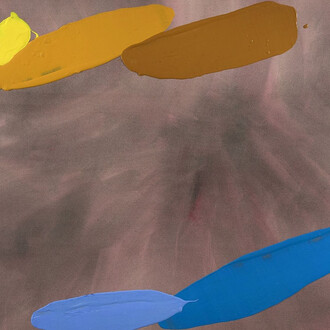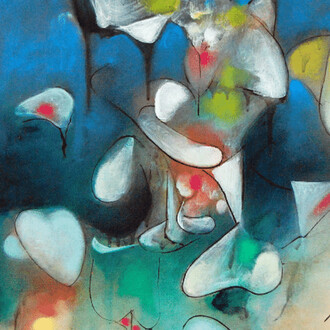Huang I-ming (b.1952, I-lan, Taiwan) is an accomplished Chinese calligrapher based in Taiwan who also has taught and exhibited extensively in the PRC. Huang has practiced calligraphy his entire life, ever since he could hold a brush as a small child. Much like in the Ming and Qing Dynasties when scholar artists were first court officials and then retired to lives of creative contemplation, Huang, after a short political career, turned to practicing and teaching calligraphy full-time. Few modern calligraphers have full mastery of all script forms, but Huang is an outstanding exception. Huang’s oeuvre includes all calligraphic scripts, from Ancient Seal Script to Han Clerical Script, Regular, Running and Cursive scripts. Teaching at the Central Academy of Fine Arts (CAFA) in Beijing, Huang absorbed the creative excitement and vigor of the art scene there. He came away with renewed enthusiasm for a “modern” calligraphic style.
For many years, calligraphy art has been my life. I have used every ounce of my being to create these lines. All the changes in these lines are produced with feelings and emotions. My frame of mind has evidently affected their creation, and they have, in return, brought me into a new realization and awareness of what is happening to the different environments, matters, and things surrounding me. This is a process of incessant cause and effect evolution. These lines have already become my entirety.
Huang further explains that a piece of Chinese calligraphy has two levels of meaning: wen yi and shu yi. The classical styles of Chinese calligraphy, according to traditional canons, have both wen yi, the literal meaning of the image in Chinese, and shu yi, the expressive content of the brushwork that expresses the feelings of the calligrapher. Some art theorists regard wen yi as the “narrative” aesthetic in contrast with shu yi, the “lyric” aesthetic of calligraphy. Just as musicians interpret a musical score, so calligraphers celebrate the execution of the characters. Huang defines this dualism in modern calligraphy as “classical linearity.”
What happens when wen yi becomes irrelevant to the creative act? The link between an actual symbol or word and brushwork is divorced and shu yi, “lyric aesthetic” becomes paramount. Huang credits the Japanese post –WWII calligrapher, Teshima Yukei of the Shosho group or “Shao Zi Pai” (or “Few Character Group), with promoting the first theoretical basis for separating wen yi from shu yi. To convey the utter despair and ruin of Japan in the late 1940’s and 1950s, Teshima believed that he could only do so by deconstructing and re-forming the written symbols of calligraphy. The resulting works allowed people who cannot read Chinese/Japanese kanji to grasp the intended wen yi or meaning of his visual perception. Inspired by this theoretical basis, Huang forged a new creative path, one where shu yi (expressive/lyrical nature of the brush) is transcendent, without specific reference to written language. Huang describes his new work as “abstract expressionism with classical linearity” and is quick to remind that his works are not paintings per se, as the brushwork is firmly rooted in the framework of calligraphy brush traditions separate from classical ink painting. Further, Huang also gives credit to the influence of Western art on his style, specifically from the Abstract Expressionist painters of the second half of the 20th Century.
The current exhibition will feature Huang’s breadth of style, from unwavering perfection of his small running script in “Autumn Stillness,” to the mesmerizing abstraction, ”Changes of Mother Earth.” The show will open for Asia Week (March 15- 24, 2018) and then continue through May 5 by appointment. This is the third exhibition of Huang’s works at M. Sutherland Fine Arts.















